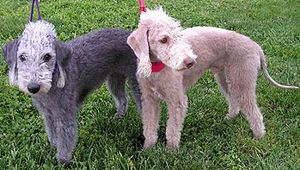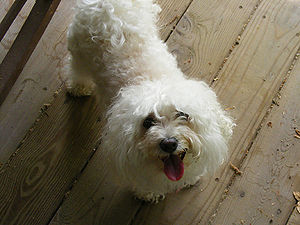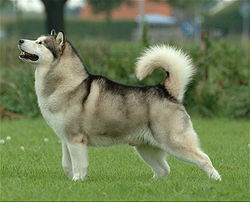 |
| Vital Statistics: |
| Place of Origin: England |
| Group: Terrier |
| Height: males 16-17 in., females 15-16 in. |
| Weight: 17-23 lbs. |
| Life span: 17 yrs. plus |
| Trainability: moderate |
| Good with children: yes |
| Good with other pets: not with dominant dogs, may chase cats & small animals |
What is the origin of the Bedlington Terrier?
The Bedlington Terrier comes from Northumberland in England. It was developed from Rothbury Terriers and other crosses. They look like lambs when clipped. Bedlingtons were used to catch vermin.
What does the Bedlington Terrier look like?
The Bedlington is 15-17 inches tall and weighs 17-23 lbs. The head is narrow and rounded with no stop. It has a profuse topkot. Ears are set low, hanging with rounded tips that have a tassel. Eyes are almond-shaped. The back is arched. The coat is a mix of hard and soft hair that has a tendency to curl and is medium long. Colors are blue, sandy and liver with or without tan points. COMB the coat once or twice a week. The coat needs shaping every other month as it sheds very little.
What is the temperament of the Bedlington Terrier?
In spite of their lamb-like appearance, Bedlintons can be fierce and agressive fighters with other dogs. They are demonstrative with their family, but reserved with strangers. Bedlingtons can be wilfull and should have early positive obedience training and socialization. Unles raised with other pets, it moight view them as prey. Bedlingtons love to run and are very fast. They will chase any moving object. They are playful and are good with children. Bedlingtons need a vigorous long daily walk and can be off-leash only on a secure area. As Bedlingtons can be aggressive with other dogs, it’s a good idea to keep a close watch of they are off-leash. With adequate exercise they can live in apartments,.
What is the Bedlington Terrier used for?
Bedlingtons are still used today to catch vermin. They make good watchdogs and are loyal and affectionate family members.
Possible Health Issues
Copper toxicosis (buildup of copper in the liver), renal cortical hypoplasia (part of the kidney under-developed), retinal dysplasia.
- Airedale Terrier
- American Pit Bull Terrier
- American Stratfordshire Terrier
- Australian Terrier
- Black Russian Terrier
- Border Terrier
- Boston Terrier
- Bull Terrier
- Cairn Terrier
- Cesky Terrier
- Dandie Dinmont Terrier
- English Toy Terrier
- Glen of Imaal Terrier
- Irish Terrier
- Jack Russell Terrier
- Lakeland Terrier
- Manchester Terrier
- Miniature Schnauzer
- Moscow Toy Terrier
- Norfolk Terrier and Norwich Terrier
- Old English Terrier
- Scottish Terrier
- Silky Terrier
- Skye Terrier
- Smooth and Wire-haired Fox Terrier
- Soft-coated Wheaten Terrier
- Tibetan Terrier
- Toy Fox Terrier
- Welsh Terrier
- West Highland White Terrier
- Wire Fox Terrier
- Yorkshire Terrier
- Airedale Terrier
- Beagle
- Bluetick Coonhound
- Border Collie
- Border Terrier
- Bull Terrier
- Bulldog
- Bullmastiff
- Ca de Bou
- Cavalier King Charles Spaniel
- Clumber Spaniel
- Collie
- Curly-coated Retriever
- Dandie Dinmont Terrier
- English Cocker Spaniel
- English Foxhound
- English Setter
- English Springer Spaniel
- English Toy Terrier
- Flat-coated Retriever
- Golden Retriever
- Greyhound
- Harrier
- Jack Russell Terrier
- Lakeland Terrier
- Lancashire Heeler
- Llewellyn Setter
- Manchester Terrier
- Mastiff
- Norfolk Terrier and Norwich Terrier
- Old English Sheepdog
- Old English Terrier
- Otterhound
- Parson Russell Terrier
- Shetland Sheepdog
- Smooth and Wire-haired Fox Terrier
- Sussex Spaniel
- Welsh Terrier
- Whippet
- Wire Fox Terrier
- Yorkshire Terrier



